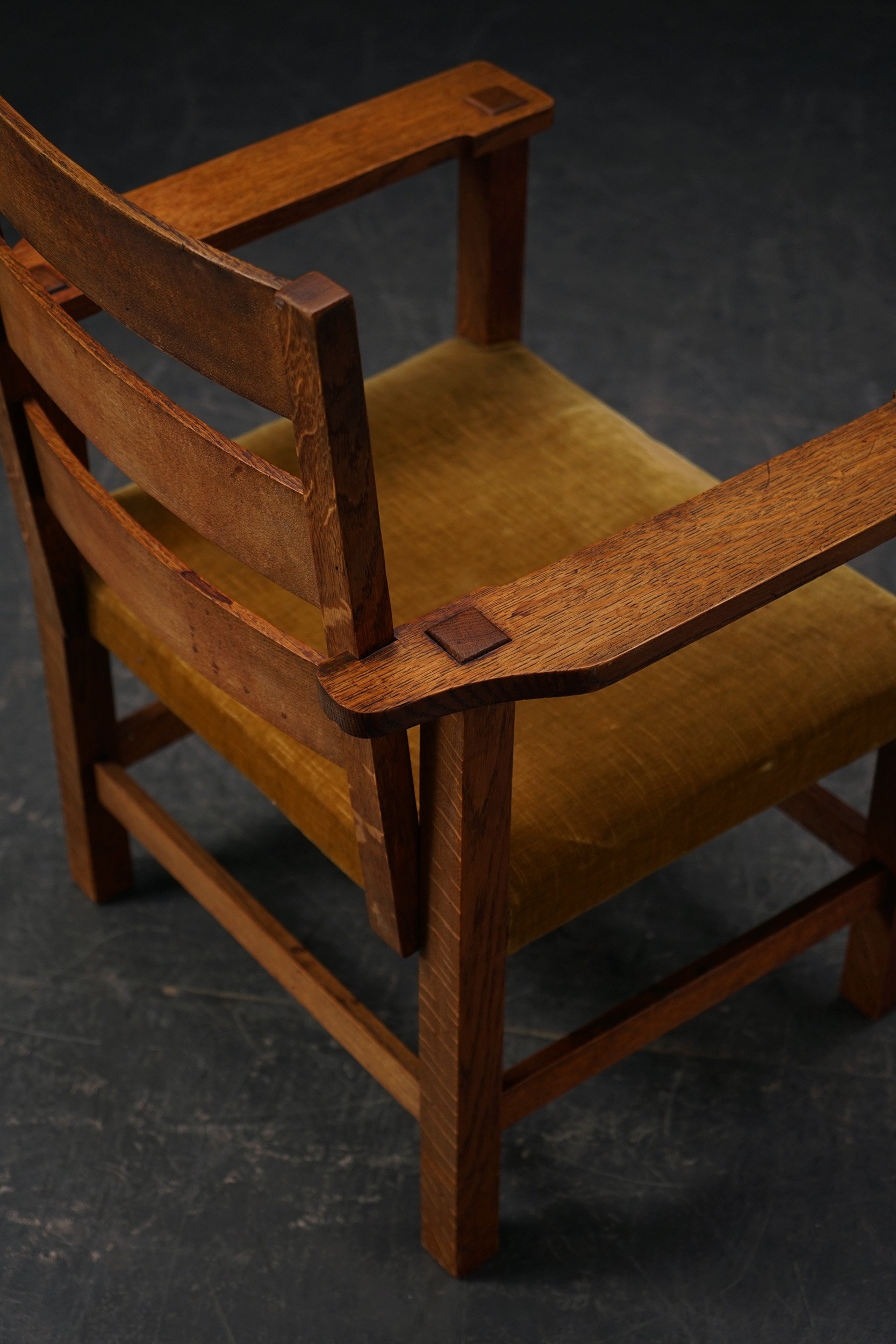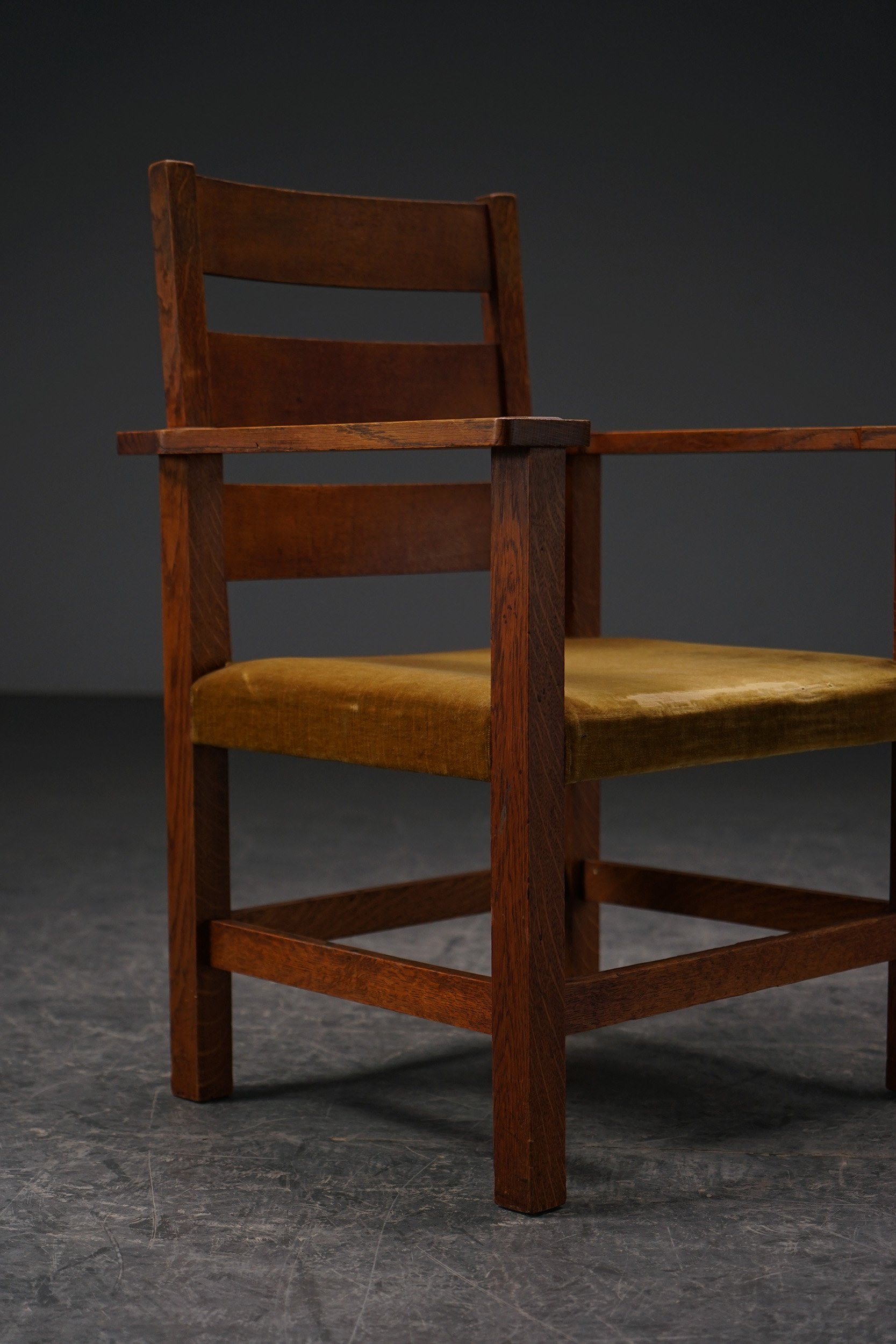 Image 1 of 17
Image 1 of 17

 Image 2 of 17
Image 2 of 17

 Image 3 of 17
Image 3 of 17

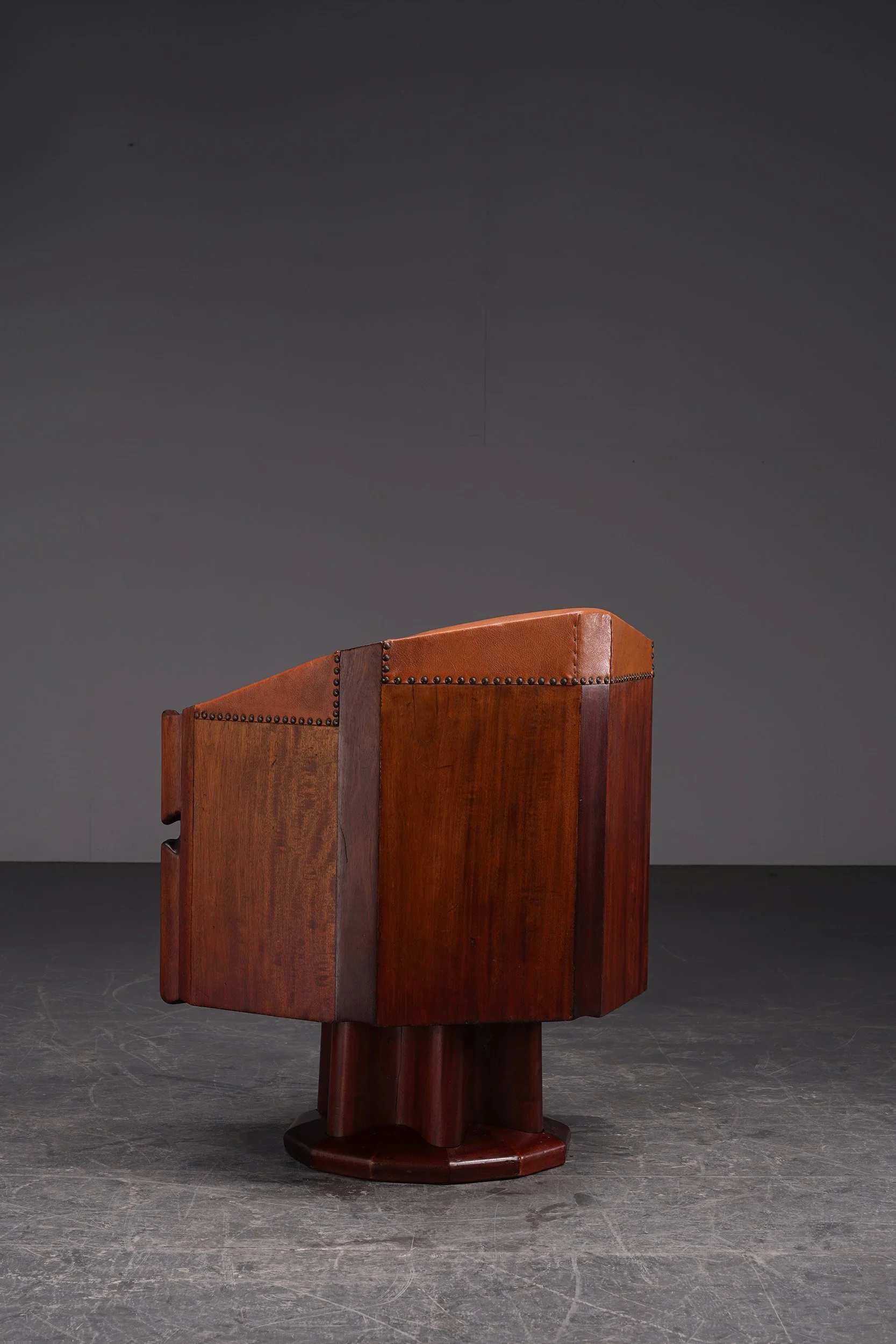 Image 4 of 17
Image 4 of 17

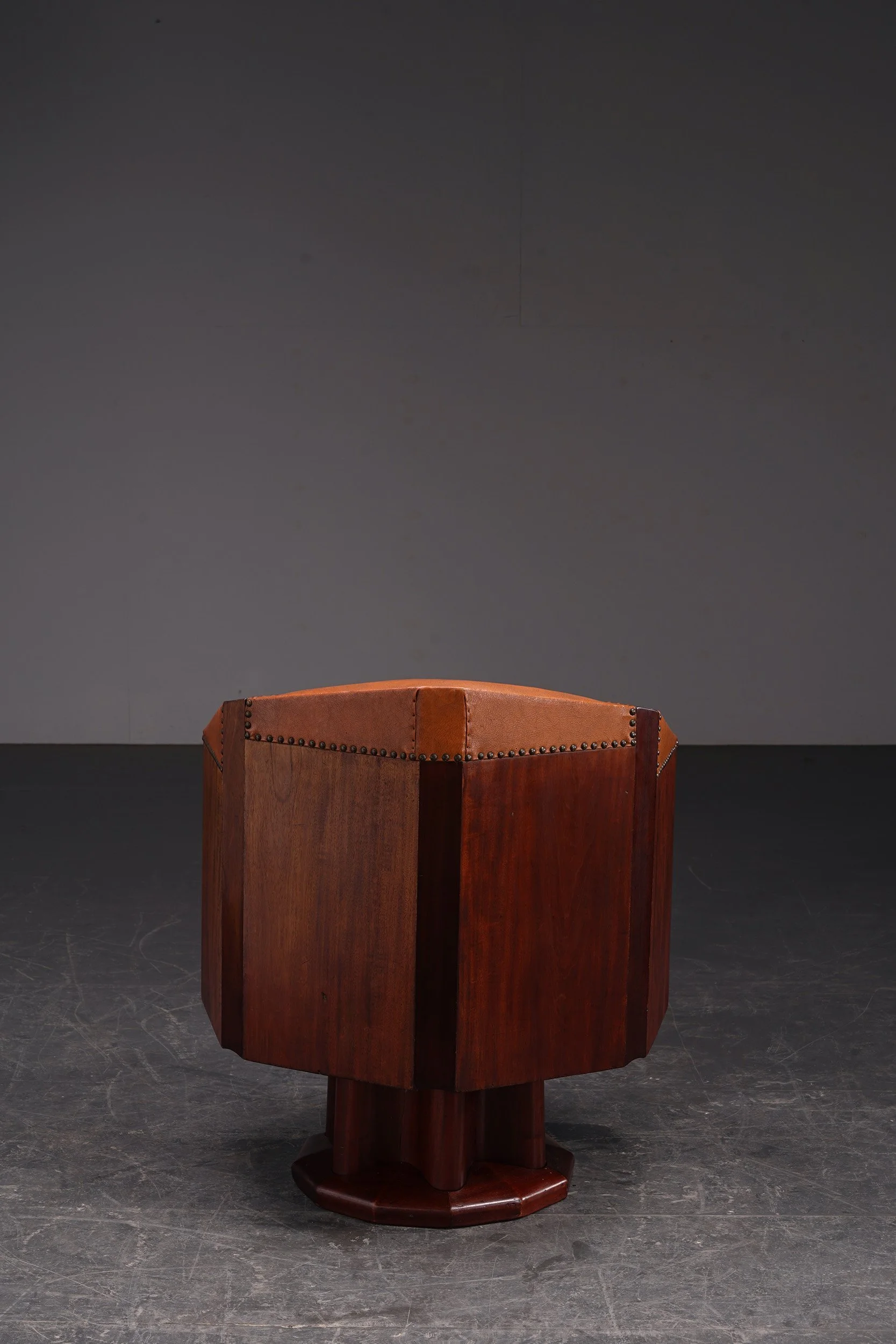 Image 5 of 17
Image 5 of 17

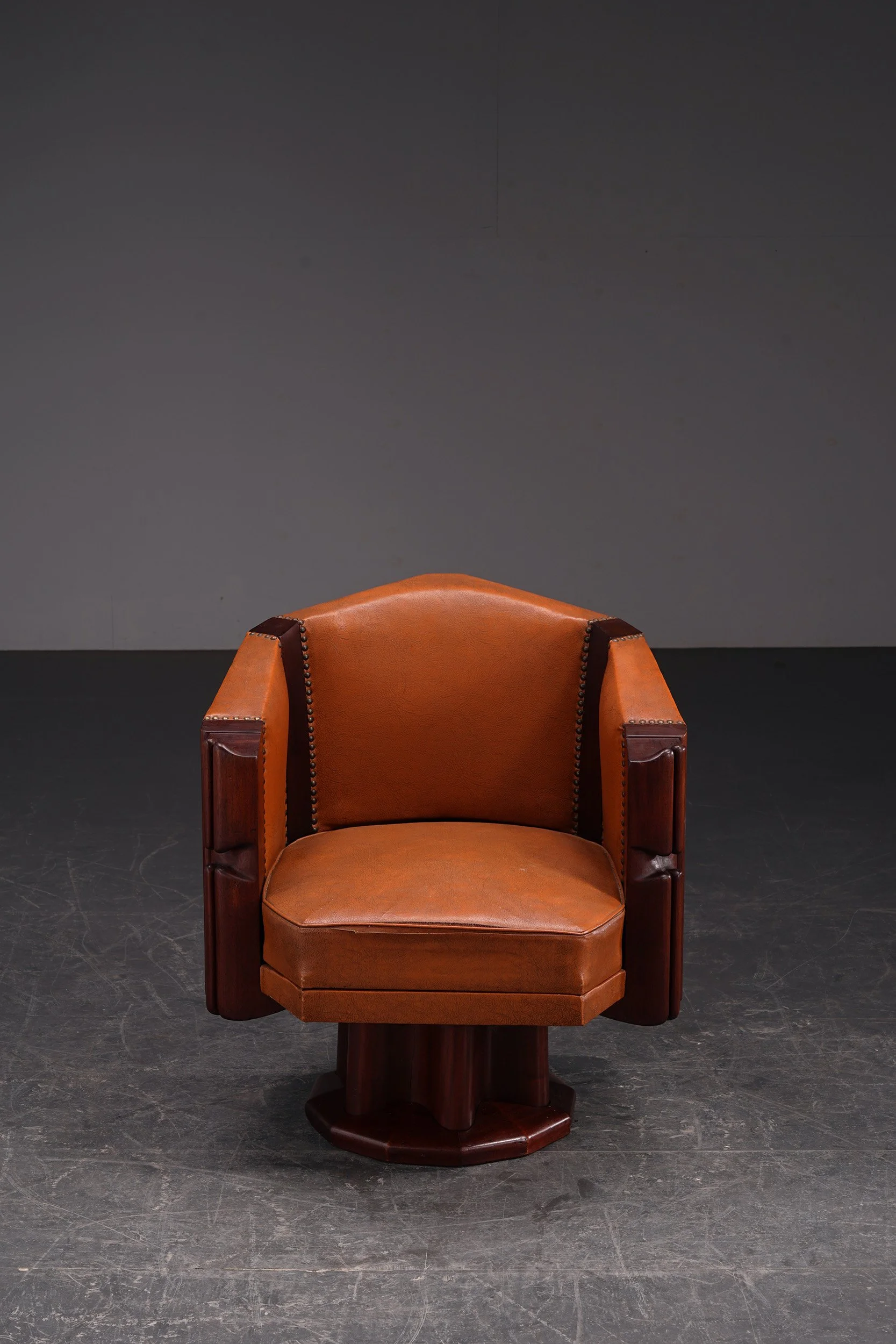 Image 6 of 17
Image 6 of 17

 Image 7 of 17
Image 7 of 17

 Image 8 of 17
Image 8 of 17

 Image 9 of 17
Image 9 of 17

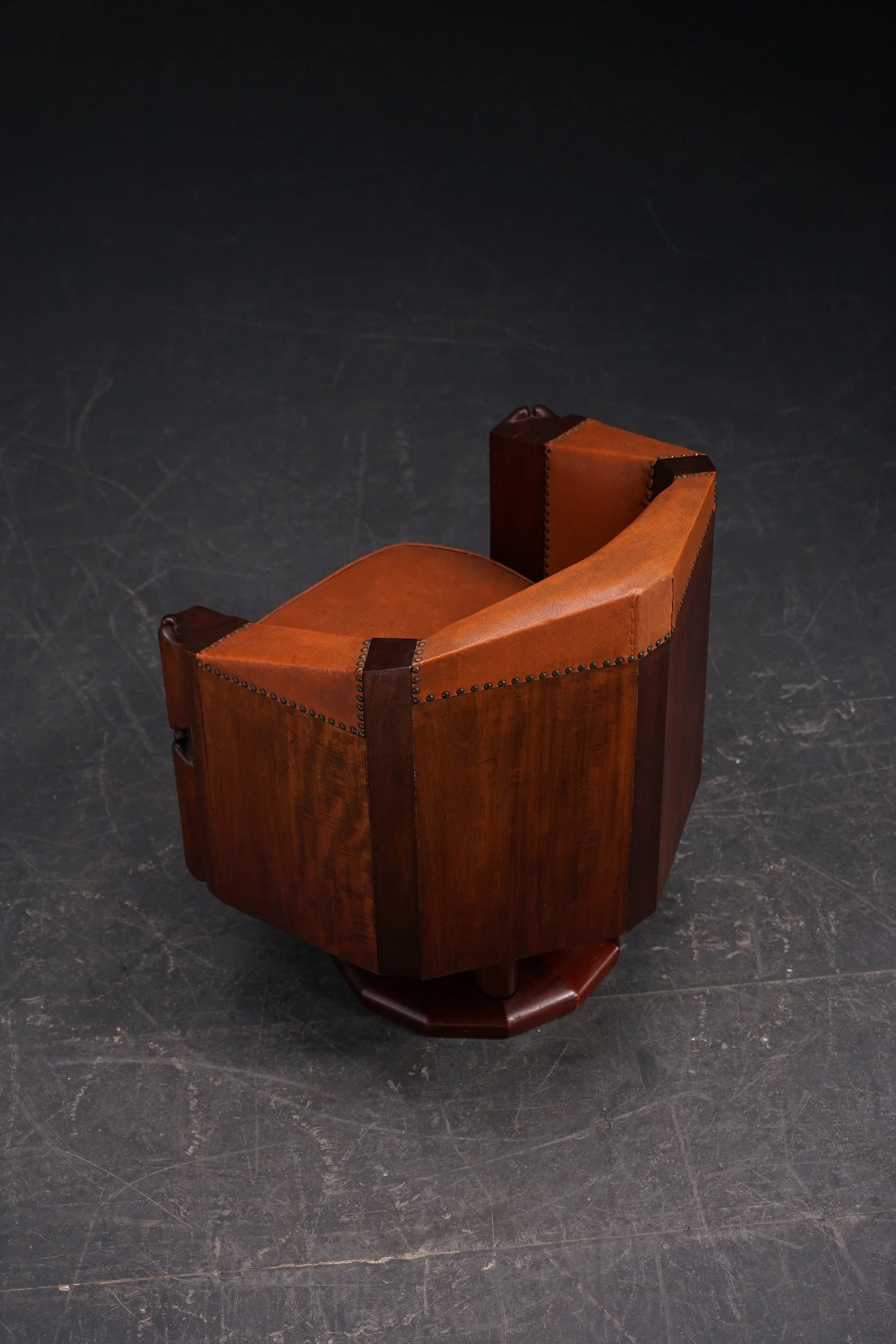 Image 10 of 17
Image 10 of 17

 Image 11 of 17
Image 11 of 17

 Image 12 of 17
Image 12 of 17

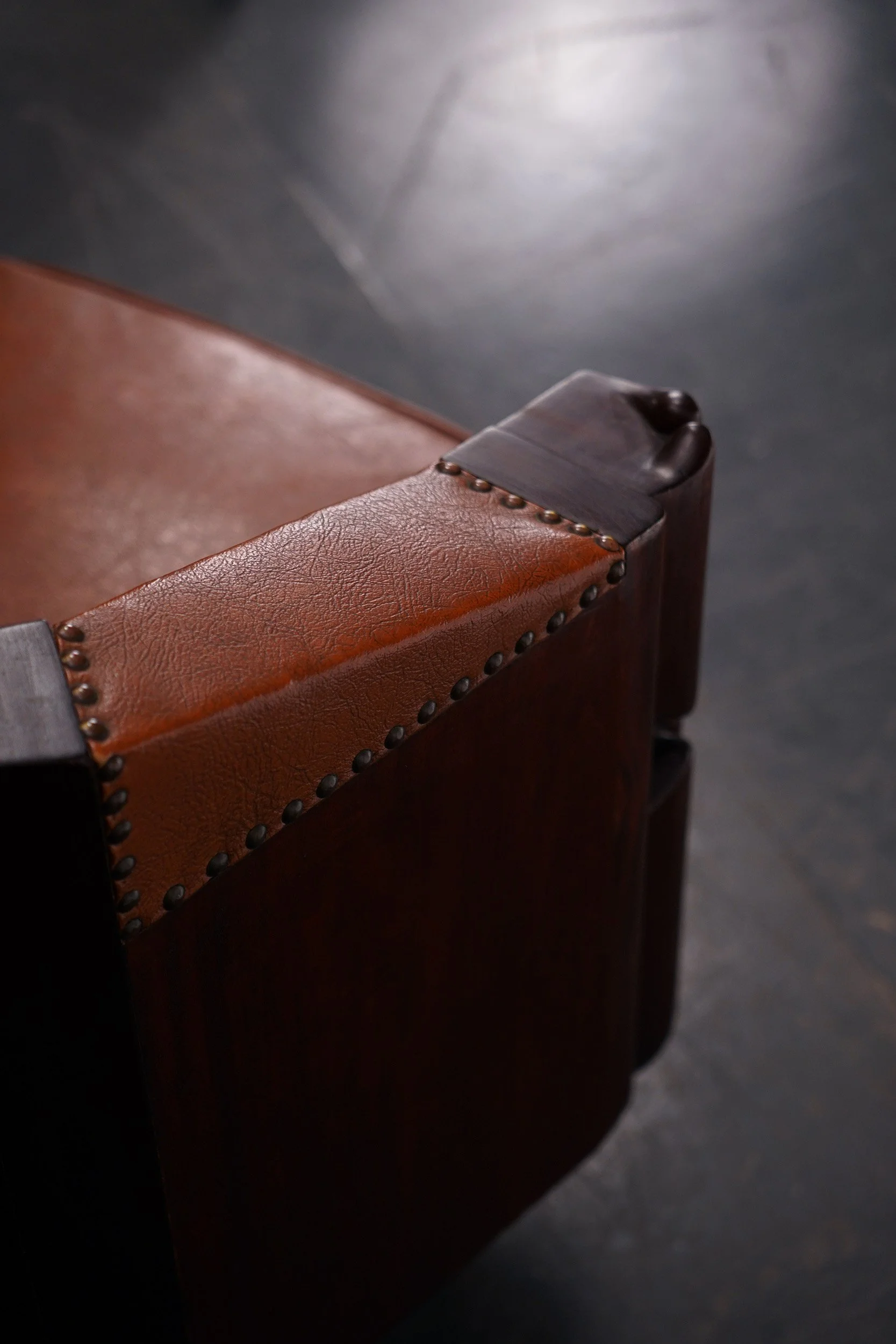 Image 13 of 17
Image 13 of 17

 Image 14 of 17
Image 14 of 17

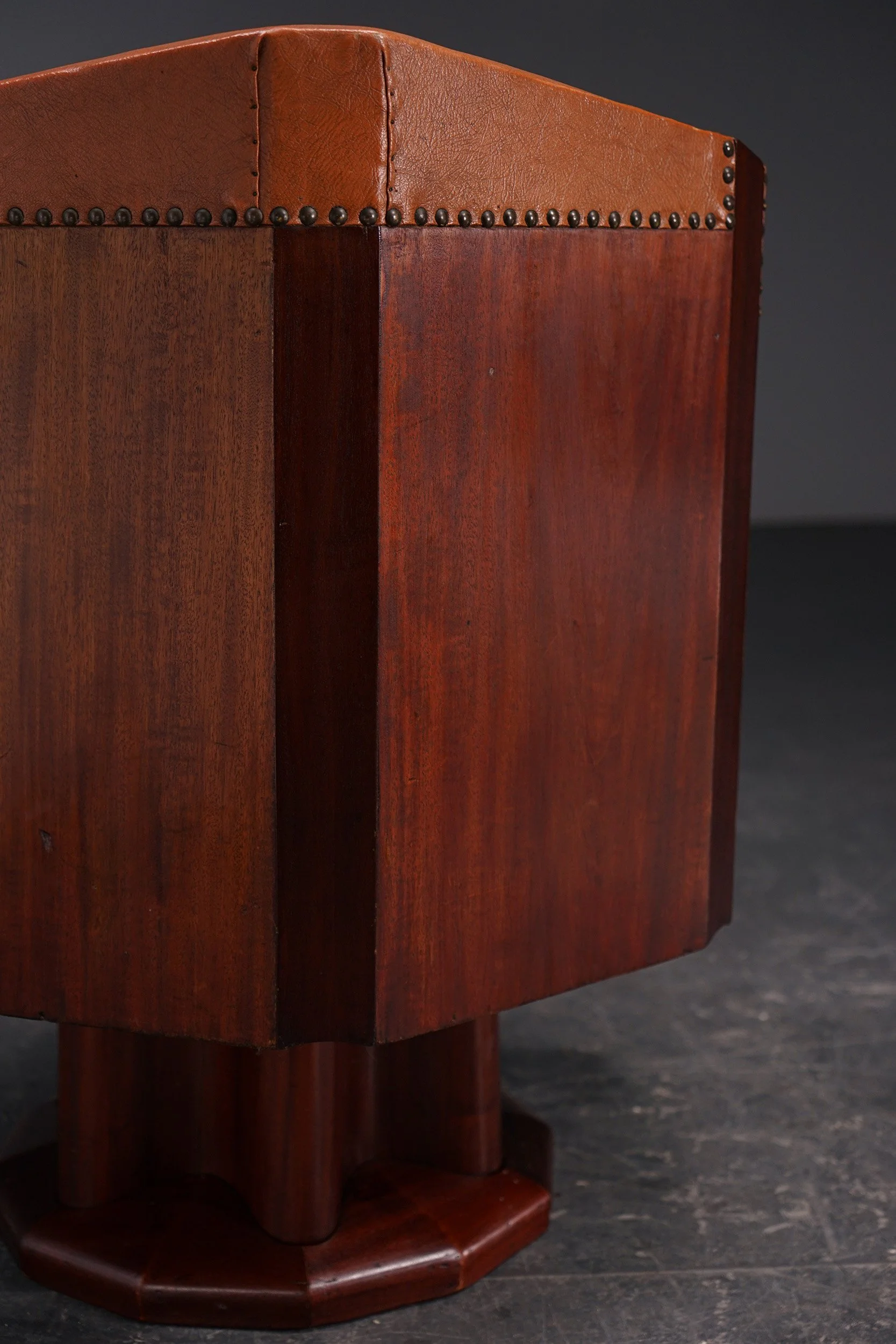 Image 15 of 17
Image 15 of 17

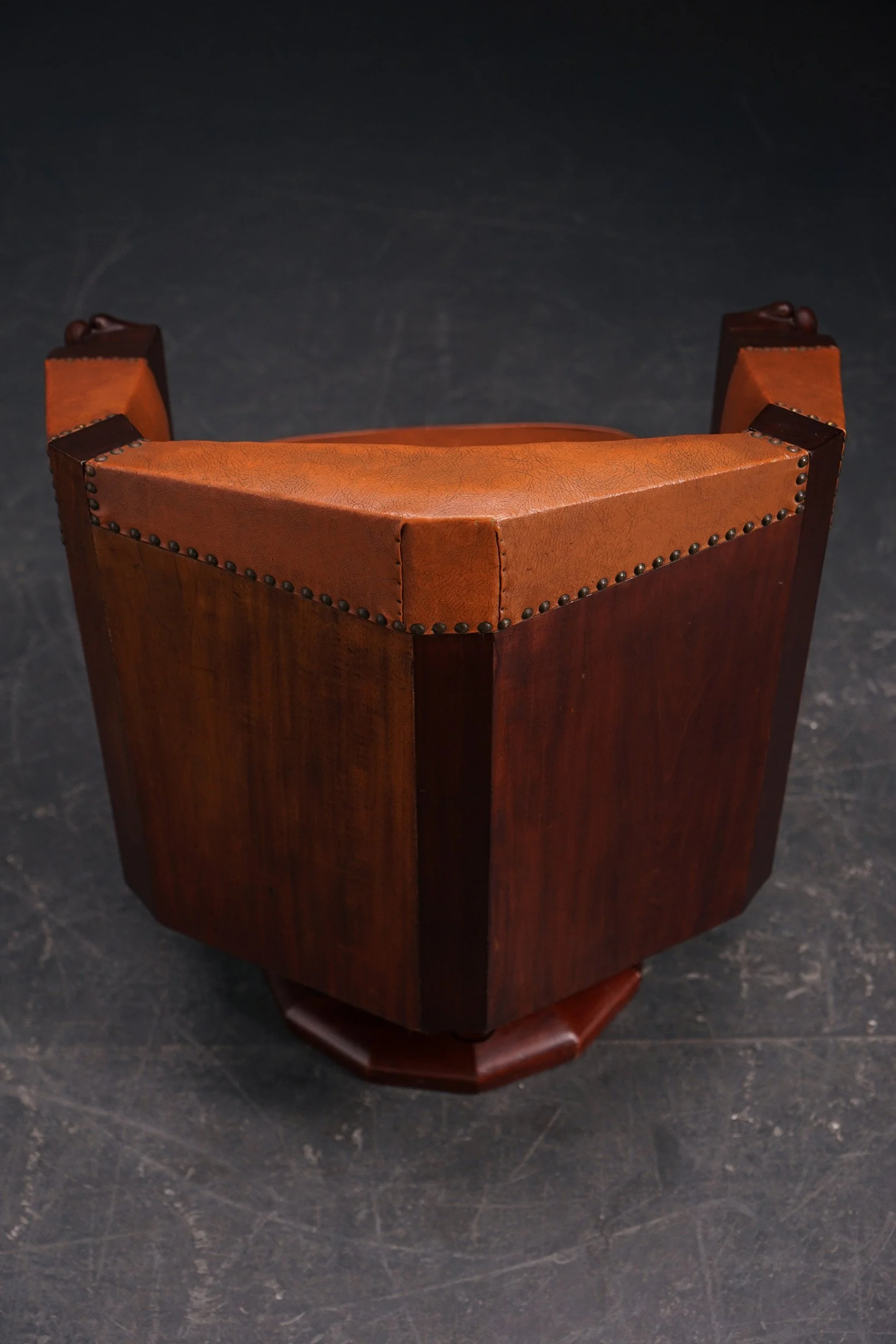 Image 16 of 17
Image 16 of 17

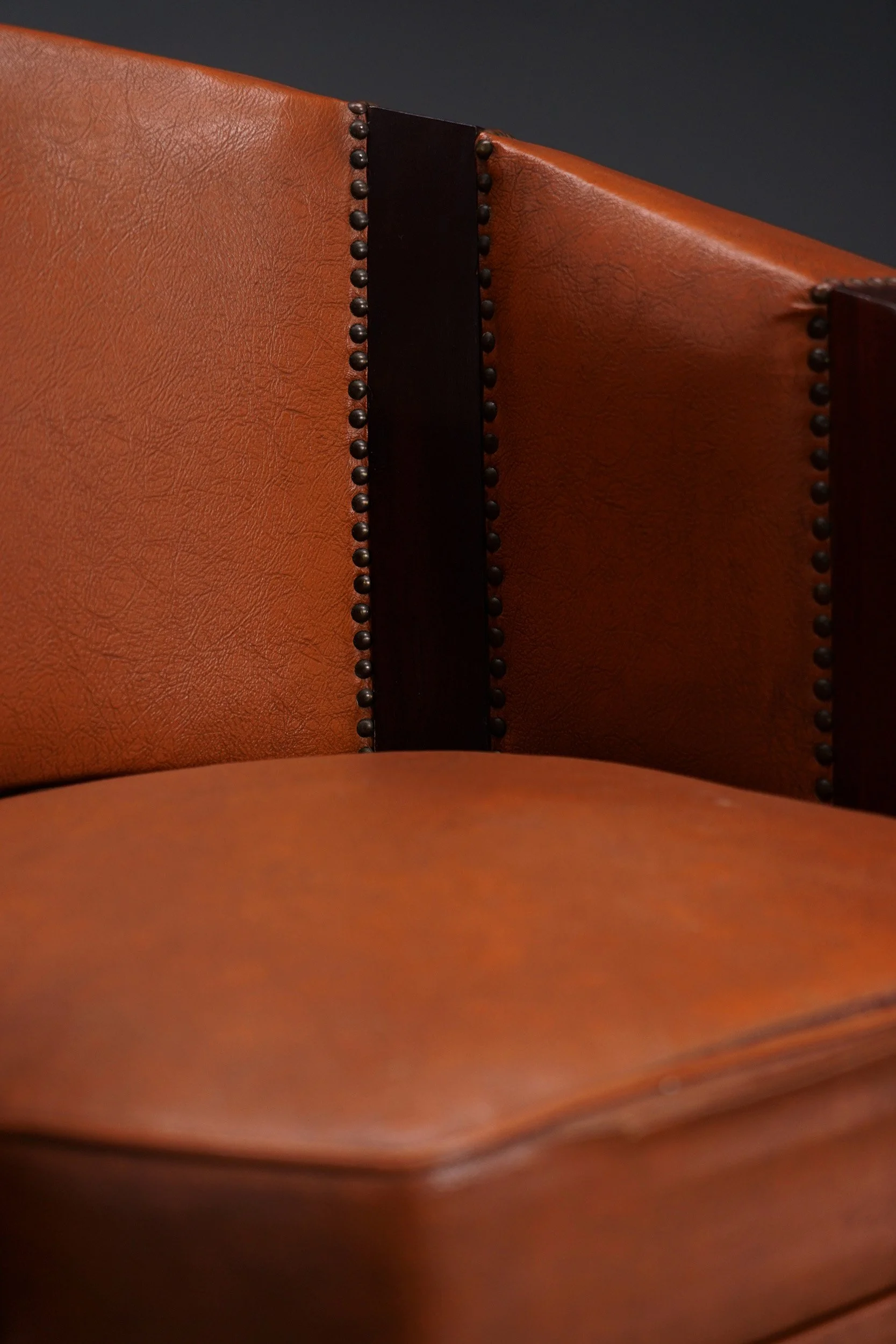 Image 17 of 17
Image 17 of 17


















Amsterdamse School Swivelling Executive Desk Chair
Architect Michel de Klerk (1884-1924)
period: 1915-1916
origin: The Netherlands
dimensions (cm): h80,5 x w71,5 x d65 cm (sh47 / ar71 cm)
dimensions (inch): h31,69 x w28,15 x d25,59 in (sh18,50 / ar27,95 in)
material: vintage upholstery, wood
Michel de Klerk (1884-1923) was undoubtedly the most prominent architect and furniture designer of Amsterdamse School, a truly unique architectural movement that emerged in the Netherlands around 1910 and flourished for a relatively brief but precious period.
Brimming with eccentric detail, Amsterdamse School is one of the most outspoken Expressionist Art Deco movements in history, strongly inspired by Indonesian culture thanks to the many ties between Indonesia and the Netherlands at the time. The typical dynamic slopes and ripples, intricate facades with sculptural ornamentation, graphic accents, expressive use of wrought iron, and beautiful wood batik staining techniques all contribute to this movement’s distinctive, almost theatrical quality, widely admired as a compelling counterpoint to the rise of more Rationalist movements. Indeed, there is nothing quite like the richness in detail, material, contrast, and colour associated with the Amsterdamse School — and its appeal is irresistible.
De Klerk’s work is easily the most emblematic of the Amsterdamse School movement. This Swivelling Desk Chair was designed especially for one of the executive offices in Het Scheepvaarthuis (1912–1916) — a monumental building that remains the epitome of the Amsterdamse School in Amsterdam today. Built as the headquarters of six major shipping companies, Het Scheepvaarthuis is in fact a Gesamtkunstwerk of extraordinary ambition and oustanding grandeur. Its design was a collaboration not only between De Klerk and fellow architects Joan van der Mey and Piet Kramer, but also an impressive array of sculptors — among which Hildo Krop —, designers, engineers, blacksmiths, and stained-glass artist Willem Bogtman. With fantastic maritime symbols and references to sea navigation, even the smallest detail in the architecture and interiors of Het Scheepvaarthuis reflect the Amsterdamse School’s signiture extravagance and originality.
True to the movement’s lavish expressiveness, its leading architects and designers were spurred to unparalleled creativity. In part, this explains why Amsterdamse School furniture designs are mostly unique or highly exclusive, often custom made for buildings financed by wealthy investors, with the luxury to be designed with exhuberant and expensive materials.
Because De Klerk was personally commissiond to design the executive offices of only one of the six shipping companies within Het Scheepvaarthuis, his Swivelling Desk Chair is a particularly rare and distinctive piece. Its design is bold in every way: straight angles and tiers combined with flowing wood pleats and a polyhedral base, the luxurious leather lined with studs like jewels. For De Klerk, a piece of furniture was, what he called, “an extrodinary entity” (“een geheel bijzonder weezen”). Only one other identical Swivelling Desk Chair from this series is known to exist. It resides in the collection of the Cultural Heritage Agency of the Netherlands (Rijksdienst voor het Cultureel Erfgoed) and is currently held in depot by the Kunstmuseum Den Haag.
The completion of Het Scheepvaarthuis helped catapult the Amsterdamse School into prominence. Its legacy would soon be expressed again in De Klerk’s exquisite design of Het Schip (1917–1920), a cherished social housing complex now partly open to the public as a museum. Other examples of this remarkable movement are to be found all over Amsterdam. Spotting them may quite literally stop you in your tracks! The peculiar artistry leaps out from its surroundings and never fails to spark awe and wonder.
Architect Michel de Klerk (1884-1924)
period: 1915-1916
origin: The Netherlands
dimensions (cm): h80,5 x w71,5 x d65 cm (sh47 / ar71 cm)
dimensions (inch): h31,69 x w28,15 x d25,59 in (sh18,50 / ar27,95 in)
material: vintage upholstery, wood
Michel de Klerk (1884-1923) was undoubtedly the most prominent architect and furniture designer of Amsterdamse School, a truly unique architectural movement that emerged in the Netherlands around 1910 and flourished for a relatively brief but precious period.
Brimming with eccentric detail, Amsterdamse School is one of the most outspoken Expressionist Art Deco movements in history, strongly inspired by Indonesian culture thanks to the many ties between Indonesia and the Netherlands at the time. The typical dynamic slopes and ripples, intricate facades with sculptural ornamentation, graphic accents, expressive use of wrought iron, and beautiful wood batik staining techniques all contribute to this movement’s distinctive, almost theatrical quality, widely admired as a compelling counterpoint to the rise of more Rationalist movements. Indeed, there is nothing quite like the richness in detail, material, contrast, and colour associated with the Amsterdamse School — and its appeal is irresistible.
De Klerk’s work is easily the most emblematic of the Amsterdamse School movement. This Swivelling Desk Chair was designed especially for one of the executive offices in Het Scheepvaarthuis (1912–1916) — a monumental building that remains the epitome of the Amsterdamse School in Amsterdam today. Built as the headquarters of six major shipping companies, Het Scheepvaarthuis is in fact a Gesamtkunstwerk of extraordinary ambition and oustanding grandeur. Its design was a collaboration not only between De Klerk and fellow architects Joan van der Mey and Piet Kramer, but also an impressive array of sculptors — among which Hildo Krop —, designers, engineers, blacksmiths, and stained-glass artist Willem Bogtman. With fantastic maritime symbols and references to sea navigation, even the smallest detail in the architecture and interiors of Het Scheepvaarthuis reflect the Amsterdamse School’s signiture extravagance and originality.
True to the movement’s lavish expressiveness, its leading architects and designers were spurred to unparalleled creativity. In part, this explains why Amsterdamse School furniture designs are mostly unique or highly exclusive, often custom made for buildings financed by wealthy investors, with the luxury to be designed with exhuberant and expensive materials.
Because De Klerk was personally commissiond to design the executive offices of only one of the six shipping companies within Het Scheepvaarthuis, his Swivelling Desk Chair is a particularly rare and distinctive piece. Its design is bold in every way: straight angles and tiers combined with flowing wood pleats and a polyhedral base, the luxurious leather lined with studs like jewels. For De Klerk, a piece of furniture was, what he called, “an extrodinary entity” (“een geheel bijzonder weezen”). Only one other identical Swivelling Desk Chair from this series is known to exist. It resides in the collection of the Cultural Heritage Agency of the Netherlands (Rijksdienst voor het Cultureel Erfgoed) and is currently held in depot by the Kunstmuseum Den Haag.
The completion of Het Scheepvaarthuis helped catapult the Amsterdamse School into prominence. Its legacy would soon be expressed again in De Klerk’s exquisite design of Het Schip (1917–1920), a cherished social housing complex now partly open to the public as a museum. Other examples of this remarkable movement are to be found all over Amsterdam. Spotting them may quite literally stop you in your tracks! The peculiar artistry leaps out from its surroundings and never fails to spark awe and wonder.
Architect Michel de Klerk (1884-1924)
period: 1915-1916
origin: The Netherlands
dimensions (cm): h80,5 x w71,5 x d65 cm (sh47 / ar71 cm)
dimensions (inch): h31,69 x w28,15 x d25,59 in (sh18,50 / ar27,95 in)
material: vintage upholstery, wood
Michel de Klerk (1884-1923) was undoubtedly the most prominent architect and furniture designer of Amsterdamse School, a truly unique architectural movement that emerged in the Netherlands around 1910 and flourished for a relatively brief but precious period.
Brimming with eccentric detail, Amsterdamse School is one of the most outspoken Expressionist Art Deco movements in history, strongly inspired by Indonesian culture thanks to the many ties between Indonesia and the Netherlands at the time. The typical dynamic slopes and ripples, intricate facades with sculptural ornamentation, graphic accents, expressive use of wrought iron, and beautiful wood batik staining techniques all contribute to this movement’s distinctive, almost theatrical quality, widely admired as a compelling counterpoint to the rise of more Rationalist movements. Indeed, there is nothing quite like the richness in detail, material, contrast, and colour associated with the Amsterdamse School — and its appeal is irresistible.
De Klerk’s work is easily the most emblematic of the Amsterdamse School movement. This Swivelling Desk Chair was designed especially for one of the executive offices in Het Scheepvaarthuis (1912–1916) — a monumental building that remains the epitome of the Amsterdamse School in Amsterdam today. Built as the headquarters of six major shipping companies, Het Scheepvaarthuis is in fact a Gesamtkunstwerk of extraordinary ambition and oustanding grandeur. Its design was a collaboration not only between De Klerk and fellow architects Joan van der Mey and Piet Kramer, but also an impressive array of sculptors — among which Hildo Krop —, designers, engineers, blacksmiths, and stained-glass artist Willem Bogtman. With fantastic maritime symbols and references to sea navigation, even the smallest detail in the architecture and interiors of Het Scheepvaarthuis reflect the Amsterdamse School’s signiture extravagance and originality.
True to the movement’s lavish expressiveness, its leading architects and designers were spurred to unparalleled creativity. In part, this explains why Amsterdamse School furniture designs are mostly unique or highly exclusive, often custom made for buildings financed by wealthy investors, with the luxury to be designed with exhuberant and expensive materials.
Because De Klerk was personally commissiond to design the executive offices of only one of the six shipping companies within Het Scheepvaarthuis, his Swivelling Desk Chair is a particularly rare and distinctive piece. Its design is bold in every way: straight angles and tiers combined with flowing wood pleats and a polyhedral base, the luxurious leather lined with studs like jewels. For De Klerk, a piece of furniture was, what he called, “an extrodinary entity” (“een geheel bijzonder weezen”). Only one other identical Swivelling Desk Chair from this series is known to exist. It resides in the collection of the Cultural Heritage Agency of the Netherlands (Rijksdienst voor het Cultureel Erfgoed) and is currently held in depot by the Kunstmuseum Den Haag.
The completion of Het Scheepvaarthuis helped catapult the Amsterdamse School into prominence. Its legacy would soon be expressed again in De Klerk’s exquisite design of Het Schip (1917–1920), a cherished social housing complex now partly open to the public as a museum. Other examples of this remarkable movement are to be found all over Amsterdam. Spotting them may quite literally stop you in your tracks! The peculiar artistry leaps out from its surroundings and never fails to spark awe and wonder.












































